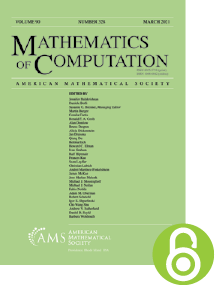Linear law for the logarithms of the Riemann periods at simple critical zeta zeros
HTML articles powered by AMS MathViewer
- by Kevin A. Broughan and A. Ross Barnett PDF
- Math. Comp. 75 (2006), 891-902 Request permission
Abstract:
Each simple zero $\frac {1}{2}+i\gamma _n$ of the Riemann zeta function on the critical line with $\gamma _n > 0$ is a center for the flow $\dot {s}=\xi (s)$ of the Riemann xi function with an associated period $T_n$. It is shown that, as $\gamma _n \rightarrow \infty$, \[ \log T_n\ge \frac {\pi }{4}\gamma _n+O(\log \gamma _n).\] Numerical evaluation leads to the conjecture that this inequality can be replaced by an equality. Assuming the Riemann Hypothesis and a zeta zero separation conjecture $\gamma _{n+1}-\gamma _n \gg \gamma _n^{-\theta }$ for some exponent $\theta >0$, we obtain the upper bound $\log T_n \ll \gamma ^{2+\theta }_n$. Assuming a weakened form of a conjecture of Gonek, giving a bound for the reciprocal of the derivative of zeta at each zero, we obtain the expected upper bound for the periods so, conditionally, $\log T_n = \frac {\pi }{4}\gamma _n+O(\log \gamma _n)$. Indeed, this linear relationship is equivalent to the given weakened conjecture, which implies the zero separation conjecture, provided the exponent is sufficiently large. The frequencies corresponding to the periods relate to natural eigenvalues for the Hilbert–Polya conjecture. They may provide a goal for those seeking a self-adjoint operator related to the Riemann hypothesis.References
- M. V. Berry and J. P. Keating, The Riemann zeros and eigenvalue asymptotics, SIAM Rev. 41 (1999), no. 2, 236–266. MR 1684543, DOI 10.1137/S0036144598347497
- P. Borwein, An efficient algorithm for the Riemann zeta function, Constructive, experimental, and nonlinear analysis (Limoges, 1999) CRC Math. Model. Ser., vol. 27, CRC, Boca Raton, FL, 2000, pp. 29–34. MR 1777614
- Kevin A. Broughan, Holomorphic flows on simply connected regions have no limit cycles, Meccanica 38 (2003), no. 6, 699–709. Dynamical systems: theory and applications (Łódź, 2001). MR 2028269, DOI 10.1023/A:1025821123532
- Kevin A. Broughan and A. Ross Barnett, The holomorphic flow of the Riemann zeta function, Math. Comp. 73 (2004), no. 246, 987–1004. MR 2031420, DOI 10.1090/S0025-5718-03-01529-1
- Kevin A. Broughan, The holomorphic flow of Riemann’s function $\xi (z)$, Nonlinearity 18 (2005), no. 3, 1269–1294. MR 2134894, DOI 10.1088/0951-7715/18/3/017
- Broughan, K.A. Phase portraits of the Riemann xi function zeros. http://www.math.waikato.ac.nz/~kab
- J. Brian Conrey, The Riemann hypothesis, Notices Amer. Math. Soc. 50 (2003), no. 3, 341–353. MR 1954010
- H. M. Edwards, Riemann’s zeta function, Dover Publications, Inc., Mineola, NY, 2001. Reprint of the 1974 original [Academic Press, New York; MR0466039 (57 #5922)]. MR 1854455
- Akio Fujii, On the difference between $r$ consecutive ordinates of the zeros of the Riemann zeta function, Proc. Japan Acad. 51 (1975), no. 10, 741–743. MR 389781
- Godfrey, P. An efficient algorithm for the Riemann zeta function, http://www.mathworks.com/support/ftp zeta.m, etan.m (2000)
- Gonek, S.M. The second moment of the reciprocal of the Riemann zeta function and its derivative, lecture at the Mathematical Sciences Research Institute, Berkeley (June 1999).
- C. P. Hughes, J. P. Keating, and Neil O’Connell, Random matrix theory and the derivative of the Riemann zeta function, R. Soc. Lond. Proc. Ser. A Math. Phys. Eng. Sci. 456 (2000), no. 2003, 2611–2627. MR 1799857, DOI 10.1098/rspa.2000.0628
- Norman Levinson and Hugh L. Montgomery, Zeros of the derivatives of the Riemann zeta-function, Acta Math. 133 (1974), 49–65. MR 417074, DOI 10.1007/BF02392141
- H. L. Montgomery, The pair correlation of zeros of the zeta function, Analytic number theory (Proc. Sympos. Pure Math., Vol. XXIV, St. Louis Univ., St. Louis, Mo., 1972) Amer. Math. Soc., Providence, R.I., 1973, pp. 181–193. MR 0337821
- Odlyzko, A. M. Correspondence about the origins of the Hilbert-Polya conjecture. http://www.dtc.umn.edu/~oldyzko/polya/
- A. M. Odlyzko, On the distribution of spacings between zeros of the zeta function, Math. Comp. 48 (1987), no. 177, 273–308. MR 866115, DOI 10.1090/S0025-5718-1987-0866115-0
- E. C. Titchmarsh, The theory of the Riemann zeta-function, 2nd ed., The Clarendon Press, Oxford University Press, New York, 1986. Edited and with a preface by D. R. Heath-Brown. MR 882550
Additional Information
- Kevin A. Broughan
- Affiliation: Department of Mathematics, University of Waikato, Hamilton, New Zealand
- Email: kab@waikato.ac.nz
- A. Ross Barnett
- Affiliation: Department of Mathematics, University of Waikato, Hamilton, New Zealand
- Email: arbus@math.waikato.ac.nz
- Received by editor(s): December 13, 2004
- Received by editor(s) in revised form: March 17, 2005
- Published electronically: November 30, 2005
- © Copyright 2005 American Mathematical Society
- Journal: Math. Comp. 75 (2006), 891-902
- MSC (2000): Primary 11M06, 11M26, 11S40
- DOI: https://doi.org/10.1090/S0025-5718-05-01803-X
- MathSciNet review: 2196998


